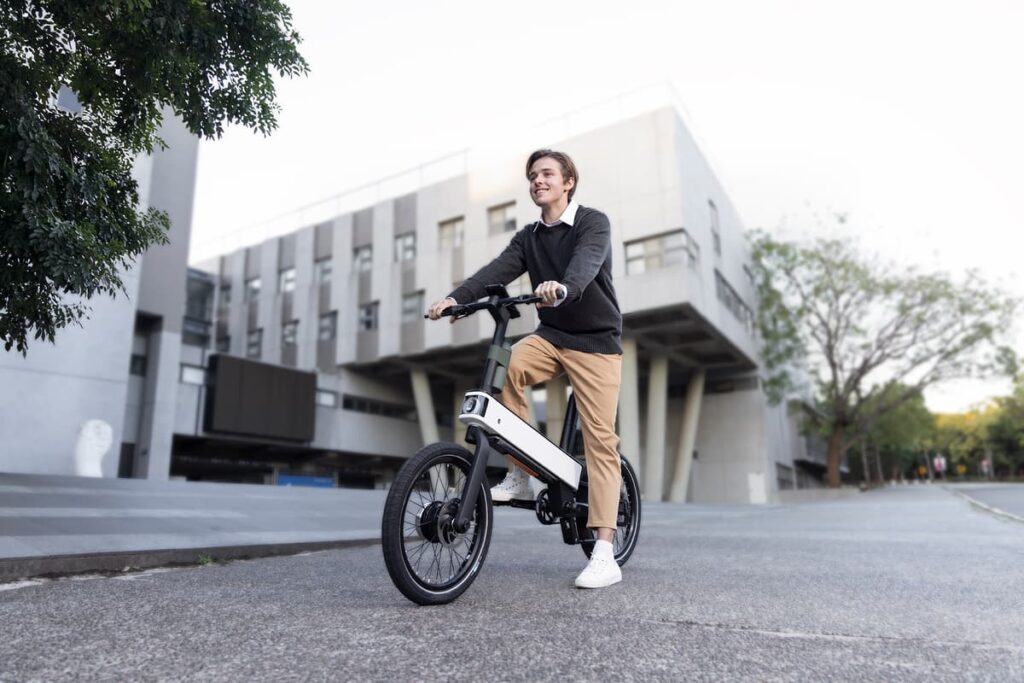An e-bike assists in varying degrees depending on the model and settings, which can be adjusted to provide more or less assistance as desired. Electric bicycles, commonly known as ebikes, have gained popularity in recent years thanks to their ability to provide assistance when pedaling.
Unlike traditional bicycles, e-bikes come equipped with an electric motor that provides additional power to the rider. However, the amount of assistance an ebike gives can vary depending on several factors. The level of assistance can be adjusted through different modes or settings provided by the bike’s manufacturer.
These modes range from low assistance, where the motor provides minimal support, to high assistance, where the motor significantly boosts the rider’s pedaling power. Riders can select the level of assistance that suits their needs, whether they prefer a challenging workout or a more effortless ride. We will explore the different levels of assistance offered by ebikes and the factors that influence them. So, let’s dive in and discover how much assistance an ebike can provide.
Understanding Ebike Assistance
Ebike assistance operates by augmenting the rider’s pedal power with the support of an electric motor. When the rider starts pedaling, the motor kicks in to provide additional power, making it easier to conquer steep inclines, cover long distances, or simply enjoy a more effortless ride. The level of assistance can be adjusted according to the rider’s preference and the terrain they are traversing.
Most ebikes have multiple levels of assistance, typically ranging from eco mode, which offers a gentle boost, to a higher power mode for more demanding conditions. Riders can select the desired assistance level using a control panel or a handlebar-mounted console, allowing them to tailor the level of support to match their cycling goals.
The electric motor in an ebike is designed to provide assistance up to a certain speed, commonly known as the maximum assisted speed. Beyond this speed, the motor gradually reduces its assistance until it eventually stops supporting the rider’s efforts. This is important to note, as it means that while an ebike can make uphill climbs more manageable and allow riders to maintain higher speeds with less effort, it won’t turn the bicycle into a fully motorized vehicle.

Credit: www.gazellebikes.com
How Does Ebike Assistance Work?
Pedal-assist is a system on an electric bike that gives you an easier time riding. Once you activate pedal-assist, the motor kicks in while you are pedaling, offering you more power. Many electric bikes provide different levels of pedal assist. Usually, these bikes have three distinct modes but can have much more. The three modes are:
- Low Assistance: 30% Power
- Medium Assistance: 60% Power
- High Assistance: 100% Power
The max speeds of pedal-assist vary depending on the bike’s class. Almost every e-bike is rated in the three-tier system. Each tier offers different advantages, but the max speed of the pedal-assist will be consistent with the bike’s rating. Once you reach the max speed of your bike’s class, the motor will stop providing assistance. Here are the pedal-assist speeds for each bike class:
- Class 1: Pedal-assist up to 20mph
- Class 2: Pedal-assist up to 20mph
- Class 3: Pedal-assist up to 28mph
Throttle, on the other hand, provides your bike with power with or without pedaling. This is what allows you to cruise and sit back and relax. The throttle system is typically activated through a twist throttle or thumb button on the handlebars. The throttle system in electric bikes is always limited to a max speed of 20mph, regardless of its classification. Class 1 e-bikes won’t have a full-throttle system, while Class 2 and 3 may or may not have one in place.
To further understand the capabilities of an ebike’s assistance system, let’s explore the different factors that affect the amount of assistance an ebike can provide.
Factors Influencing Ebike Assistance
Several factors come into play when determining the amount of assistance an ebike can provide. These include:
| Factor | Description |
|---|---|
| Battery Capacity | A larger battery capacity allows for more assistance over longer distances, as it can store and deliver more energy. |
| Motor Power | A higher motor power output results in greater assistance potential, enabling riders to tackle steeper hills or accelerate more quickly. |
| Assistance Level | The selected assistance level determines the amount of support the motor provides, with higher levels offering more assistance. |
| Riding Conditions | The specific terrain, such as hills or flats, and external factors like wind or road surface quality, can impact the effectiveness and range of ebike assistance. |
By considering these factors, riders can make informed decisions when choosing an ebike and selecting the level of assistance that aligns with their needs and preferences. Whether it’s for commuting, leisurely rides, or conquering challenging terrains, ebike assistance can contribute to a more enjoyable cycling experience.
Levels Of Ebike Assistance
Ebikes, also known as electric bikes, are gaining popularity as a convenient and eco-friendly means of transportation. One of the standout features of an ebike is its ability to provide assistance to the rider while pedaling, making it easier to cover long distances and tackle steep hills. The level of assistance an ebike can give varies, and understanding these levels can help you choose the right bike for your needs. In this blog post, we will explore the different levels of ebike assistance and their features.
Low Assist Level
At the low assist level, an ebike provides minimal assistance to the rider. This level is ideal for those who still want to exert a moderate amount of effort while riding. On a low assist level, the motor kicks in only when the rider applies a certain amount of force. This setting is perfect for riders who want to maintain an active lifestyle but may need a little help with challenging terrain or riding against the wind.
Medium Assist Level
The medium assist level on an ebike offers a balanced level of assistance, making it suitable for riders who want a blend of effort and ease. In this mode, the motor provides moderate support, kicking in when the rider applies a modest amount of force to the pedals. This level of assistance allows riders to cover longer distances without feeling too fatigued. It is also beneficial if you have errands to run or need to commute to work.
High Assist Level
The high assist level on an ebike delivers maximum assistance to the rider, allowing for a significantly reduced amount of physical effort. This mode is ideal for those who may have physical limitations or simply want to enjoy a leisurely ride without breaking a sweat. In this setting, the motor provides strong assistance even with minimal pedaling effort. Riders can effortlessly conquer steep hills and cover long distances in a fraction of the time. The high assist level is perfect for recreational rides or when you need a quick burst of speed.
Factors Affecting Ebike Assistance

Credit: www.cpr.org
When it comes to electric bikes, understanding the factors that affect their assistance is crucial. These factors determine how much assistance an ebike provides, and play a significant role in shaping your overall riding experience. By examining the battery level, terrain, and rider input, we can better comprehend the capabilities and limitations of an ebike.
Battery Level
The battery level of an ebike directly influences the level of assistance it provides. As the battery drains, the power output diminishes, resulting in reduced assistance. Therefore, it is essential to consider the battery’s current charge before embarking on a ride. While most ebikes on the market today can cover a significant distance on a single charge, it’s important to be mindful of your battery level to maintain optimal assistance throughout your journey.
Terrain
The terrain you ride on is another key factor affecting ebike assistance. Electric bikes are designed to handle various terrains, but the level of assistance may fluctuate depending on whether you’re riding on flat ground, ascending a hill, or tackling rough and uneven surfaces. When faced with uphill slopes, the motor’s power output increases to help you conquer the climb effortlessly. Conversely, when riding downhill or on a level road, the assistance may not be as pronounced, allowing you to pedal with more independence.
Rider Input
Rider input plays a crucial role in determining the assistance provided by an ebike. Unlike traditional bicycles, electric bikes feature different modes that allow riders to choose the level of assistance they desire. These modes, such as eco, normal, and sport, dictate how much power the motor contributes to your pedaling effort. For instance, in eco mode, the assistance is more conservative, providing a gentle boost to your pedal strokes. Conversely, in sport mode, the motor delivers maximum power, amplifying your efforts significantly. By selecting the appropriate mode, riders can tailor their ebike’s assistance to match their preferences and riding style.
Understanding the interplay between battery level, terrain, and rider input is essential in comprehending how much assistance an ebike can provide. By considering these factors, you can optimize your overall riding experience and ensure that your electric bike meets your expectations and needs.
Frequently Asked Questions For How Much Assistance Does An Ebike Give
How Much Do Electric Bikes Assist You?
Electric bikes provide assistance to riders, making pedaling easier and more enjoyable. The level of assistance depends on the bike model and settings. With electric bikes, you can expect varying degrees of assistance, which can be adjusted to suit your needs and desired level of effort.
How Much Does Electric Bike Help?
Electric bikes offer significant assistance by providing pedal-assist and/or full electric power, making cycling easier and less strenuous. They help riders to conquer hills, cover longer distances, and commute with less effort. Electric bikes promote physical activity while offering a convenient and eco-friendly alternative to traditional transportation methods.
How Does The Assist Work On An Ebike?Ebike Assistance Levels
The assist on an ebike works by providing a boost to your pedal power, making it easier to ride. When you start pedaling, the motor kicks in and provides additional power, allowing you to go faster and conquer hills with less effort.
How Helpful Are Ebikes?
Ebikes are very helpful as they provide an efficient and eco-friendly means of transportation. They offer pedal-assist and electric power options, making it easier to tackle inclines and cover longer distances. Ebikes are also great for fitness, reducing traffic congestion, and saving money on fuel and maintenance costs.
How Much Assistance Does An Ebike Give?
An ebike provides pedal-assist with various levels of assistance, helping riders go further and overcome challenging terrains.
Conclusion
To sum up, the assistance provided by an ebike can greatly enhance your cycling experience. With various levels of support and the ability to adjust the motor’s power, riders can access just the right amount of help they need. Whether it’s tackling hilly terrains, covering long distances, or simply making the ride a little easier, an ebike can be a game-changer.
So, if you’re looking to elevate your cycling adventures, consider embracing the assistance an ebike can offer.




